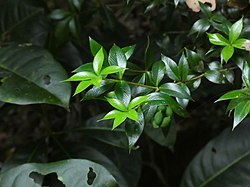| Chain fruit | |
|---|---|
 | |
| Scientific classification | |
| Kingdom: | Plantae |
| Clade: | Tracheophytes |
| Clade: | Angiosperms |
| Clade: | Eudicots |
| Clade: | Asterids |
| Order: | Gentianales |
| Family: | Apocynaceae |
| Genus: | Alyxia |
| Species: | A. oblongata |
| Binomial name | |
| Alyxia oblongata | |
| Synonyms [3] | |
| |
Alyxia oblongata, commonly known as the chain fruit, prickly lixy, or prickly Alyxia, is a plant in the dogbane family Apocynaceae endemic to a small part of northeastern Queensland.



